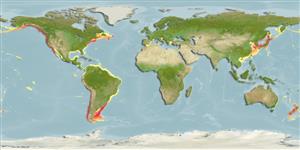Common names from other countries
Environment: milieu / climate zone / depth range / distribution range
экология
донно-пелагический; пределы глубины 50 - 330 m (Ref. 116551). Subtropical; 68°N - 48°S, 122°E - 63°E
Arctic. Pacific Ocean, Atlantic Ocean, Mediterranean and Western Indian Ocean: from China to Alaska, south to Argentina and east to Oman.
Length at first maturity / Size / Вес / Возраст
Maturity: Lm ? range ? - ? cm Max length : 60.0 cm WD самец/пол неопределен; (Ref. 2992)
Up to 50 to 60 cm wide; 16 wide, simple velar lappets containing 5 to 8 simple, blindly ending centrifugal canals; tentacles in 16 clusters arising in a single row below the ring canal, each group curved with the concavity outwards.
Reported to have symbiotic hyperiids on its subumbrella (Ref. 116551).
Life cycle and mating behavior
половая зрелость | размножение | нерест | икра | Fecundity | личинки
Members of the class Scyphozoa are gonochoric. Life cycle: Egg is laid by the adult medusa which later develops into a free-living planula, then to a scyphistoma to a strobila, and lastly to a free-living young medusa.
Основная ссылка
ссылки | координатор | соавторы
Cairns, S.D., D.R. Calder, A. Brinckmann-Voss, C.B. Castro, D.G. Fautin, P.R. Pugh, C.E. Mills, W.C. Jaap, M.N. Arai, S.H.D. Haddock and D.M. Opresko. 2003. (Ref. 1663)
Статус Красного Списка МСОП (Ref. 130435)
Статус СИТЕС (Ref. 108899)
Not Evaluated
Not Evaluated
Использование человеком
| FishSource |
инструменты
дополнительная информация
Возраст/РазмерыростЗависимость между длиной и массой телаЗависимость между длинамиморфологияличинкичисленность
ресурсы в Интернет
Estimates based on models
Уязвимость
Moderate vulnerability (44 of 100).
Категория цены
Unknown.
